There are many good reasons to reduce weight in aircraft, but for engine shop Ly-Con, the push to slim down came from Red Bull air racers. Of course the racers wanted a better power-to-weight ratio, but more importantly, they simply wanted less mass and a tighter center of gravity to help negotiate the violent transitions of the Red Bull courses.
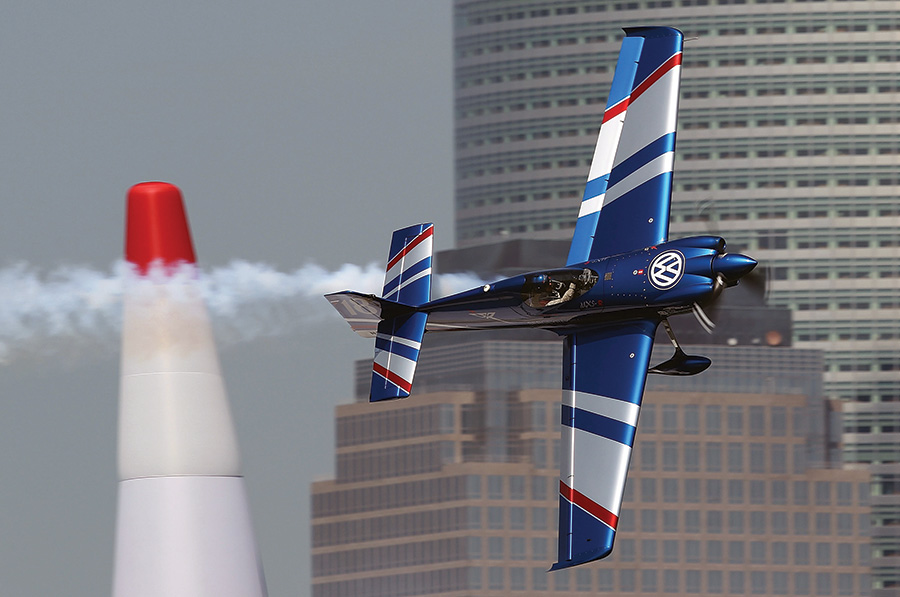
Once the available horsepower was developed in Red Bull Air Racing engines, the emphasis turned to lighter engines. They allowed for concentration of weight at the airplane’s CG for snappier turn entries and less induced drag in the turns.
This was no idle matter to Ly-Con of Visalia, California. Besides the usual standard-category overhaul business, the engine house has a long history of supplying Experimentals, Reno racers and top-flight aerobatic professionals with hot-rodded Lycomings and Continentals. Such is their reputation for power, dependability and innovation that by the time the Red Bull competition concluded in 2010, Ly-Con was supplying hot 540 Lycomings to 12 of the 15 competitors.
Today Ly-Con is still developing the lightweight Lycoming lessons learned from Red Bull. Pros such as Sean Tucker and Skip Stewart continue to ask for more, and an entirely new market of Tundra-tired backcountry airplanes is looking to reduce weight wherever possible. Special lightened Lycoming parts are becoming available, and we figured a quick review of Ly-Con’s lightweight program might give you some ideas of your own.
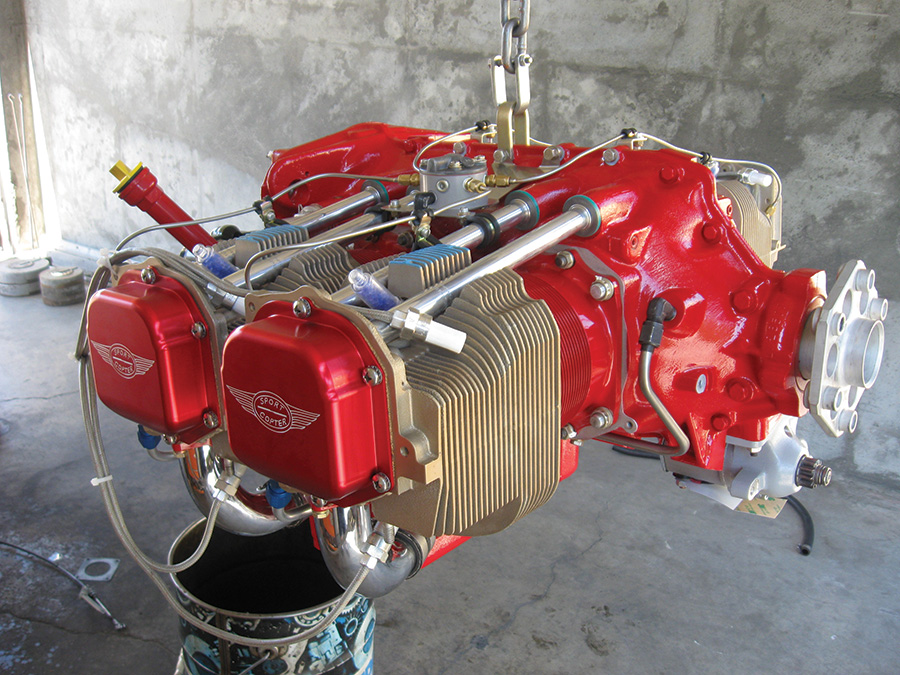
Helicopters are another segment where minimum weight is a maximum attribute. This Sport Copter engine, about to go on Ly-Con’s dyno, illustrates that aside from a few externals such as the hexagonal crank flange and featherweight valve covers, engine lightening has little visual impact.
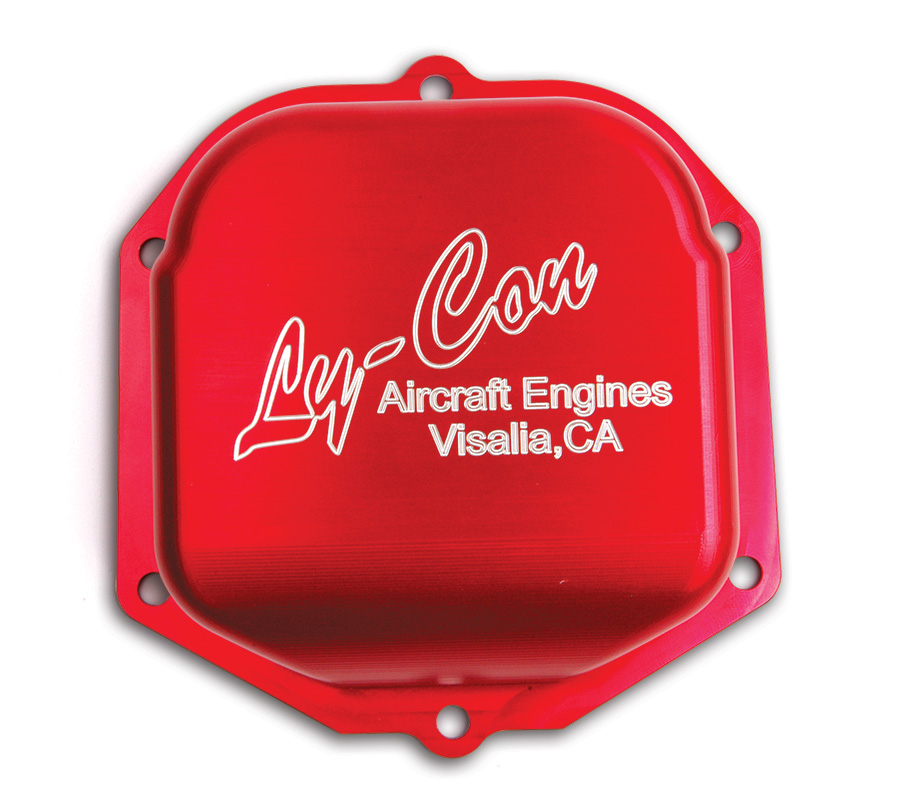
Everything considered, Lycoming’s stock stamped steel valve covers, plus a little paint or powder coating and stock screws, are likely still the lightest option. But if custom script lettering and red or black anodizing are an attraction, Swiss-Aero’s $115 billet 6061 aluminum valve covers for the 320, 360 and 540 Lycomings are new. They are very thin and maybe an ounce lighter than the stock steel covers, but much lighter than cast-aluminum covers. Ly-Con is currently evaluating a set for durability.
Racing Lessons
We should recall wide-deck 540s were the standard Red Bull engine because they are one of the lightest big displacement engines available that can really muscle out power—over 400 horsepower in very high-compression Red Bull trim. Because Lycoming’s 540 and 360 engines share the same cylinder and employ similar crankcase architecture, the Red Bull tweaks are also directly applicable to the four-cylinder 360 versions so popular today.
Naturally, when Ly-Con started on its lightening program, the company was already using lightweight accessories along with lightweight aftermarket intake and exhaust systems. Simple, custom six-into-one collected exhaust systems on Red Bull racers supported horsepower through reduced backpressure and concentrated exhaust heat for good smoke oil operation. The intakes seem to mainly have come from Sky Dynamics (Ly-Con does not make its own intake), using magnesium sumps and thin-wall aluminum intake tubes. Other brands use mild-steel intake tubes, which Ly-Con replaces with aluminum tubes. The smaller sumps, mated with these cold-air intakes, save two quarts of oil as well, an easy weight reduction.
Inside the engine, Ly-Con started with the pistons. They were already offering their own line of NFS forgings, and it proved easy to machine away more material with no ill effects. Shorter and thinner piston pins were also straightforward to develop; more weight was saved by eliminating the piston pin plugs and using circlips for retention.
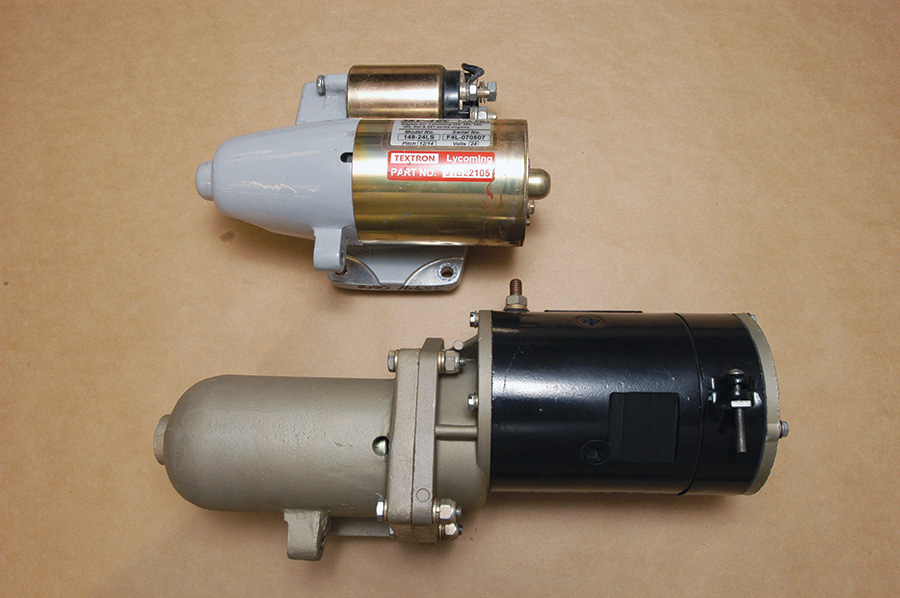
Best bang for the buck in engine lightening is a lightweight starter motor. Ly-Con may use Sky-Tec’s original 8.25-pound LS starter for standard-compression engines, but more typically fits the slightly heavier High Torque version because so many Ly-Con engines are high-compression Experimentals. The Sky-Tecs are 8–10 pounds lighter than the stock Lycoming unit shown at bottom.
Next Ly-Con developed a program to cost effectively machine Lycoming 360/540 cylinders in the in-house CNC machining center. The barrel fins were tapered, the flanges scalloped to eliminate unnecessary metal, and the bloated rocker shaft bosses whittled down to fighting weight.
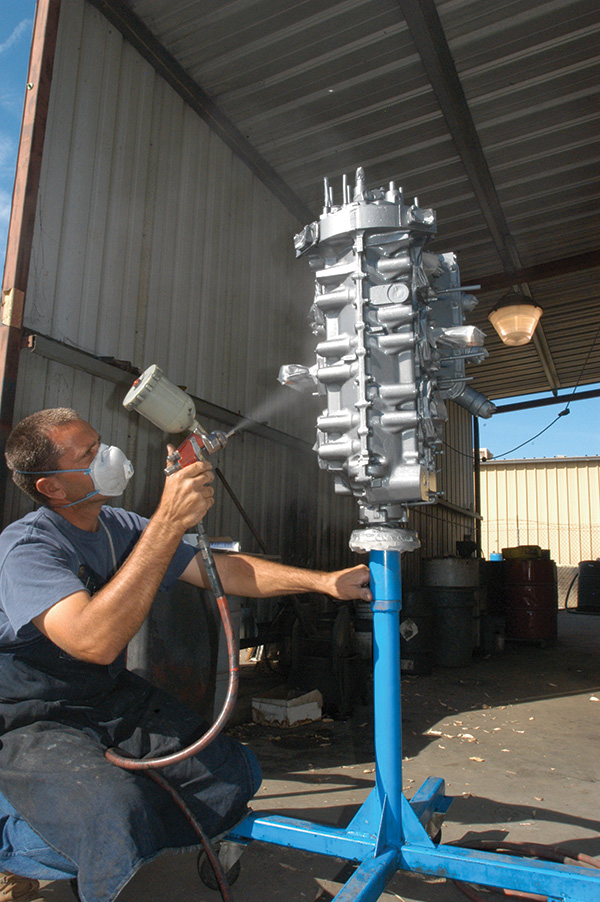
Get carried away with lightening and you’ll find all sorts of ways to trim ounces. As Ken Tunnell at Ly-Con said, “If you are counting by the gram, it all adds up. Put a quart of paint on it and some chrome and you’ve added 9 pounds of weight. That stuff is heavy.” He also noted 12-point nuts are lighter than the standard hex-head hardware, and there are customers considering no paint at all on their engines. Sounds like corrosion to us.
And did you know that besides the commonly understood lighter narrow-deck and heavier wide-deck variations of Lycoming’s cases and cylinders, there is an even more rare mid-deck? Those cylinders are 1 pound lighter than a wide deck but a little stronger than a narrow deck; Ly-Con makes up the slight height difference of the cylinder with custom NFS pistons.
Amazingly, combining the piston, pin and cylinder mods yields a 3-pound savings per cylinder. It’s hard to believe there’s that much wasted mass in one jug—some of it reciprocating weight, no less—but the steel cylinder flange is a particularly efficient place to reduce material because it’s so much heavier than aluminum.
Looking at connecting rods, Ly-Con sorted through the Lycoming and aftermarket offerings to arrive at certain stock rods that are lighter than others, and for the all-out race motors, a limited-lifespan airboat aluminum connecting rod was sometimes used. But you don’t want it in your Harmon Rocket engine.
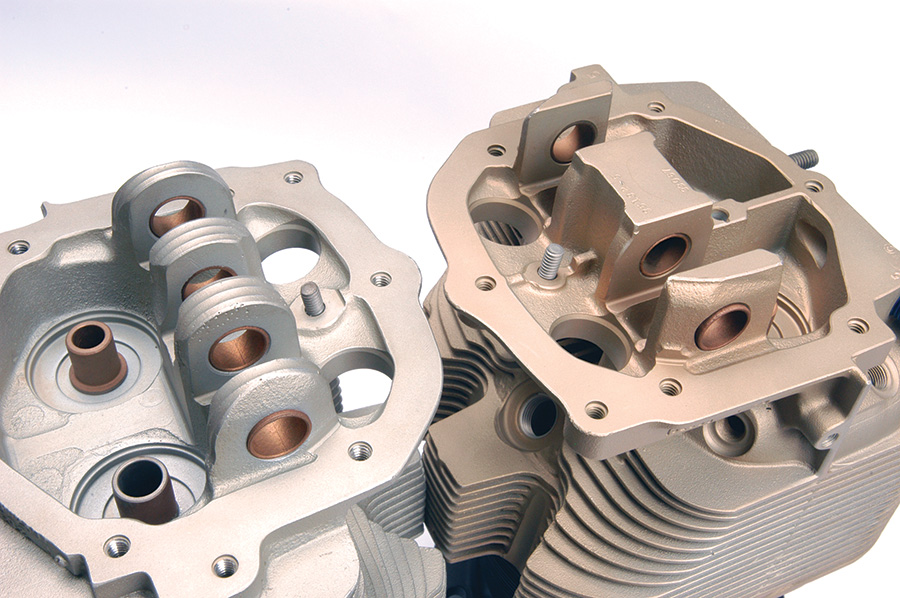
The rocker-arm shaft bosses really spend some time under the CNC knife, as seen on the modified cylinder at left. There is no loss in rocker-arm rigidity from this mod, just a lighter cylinder.
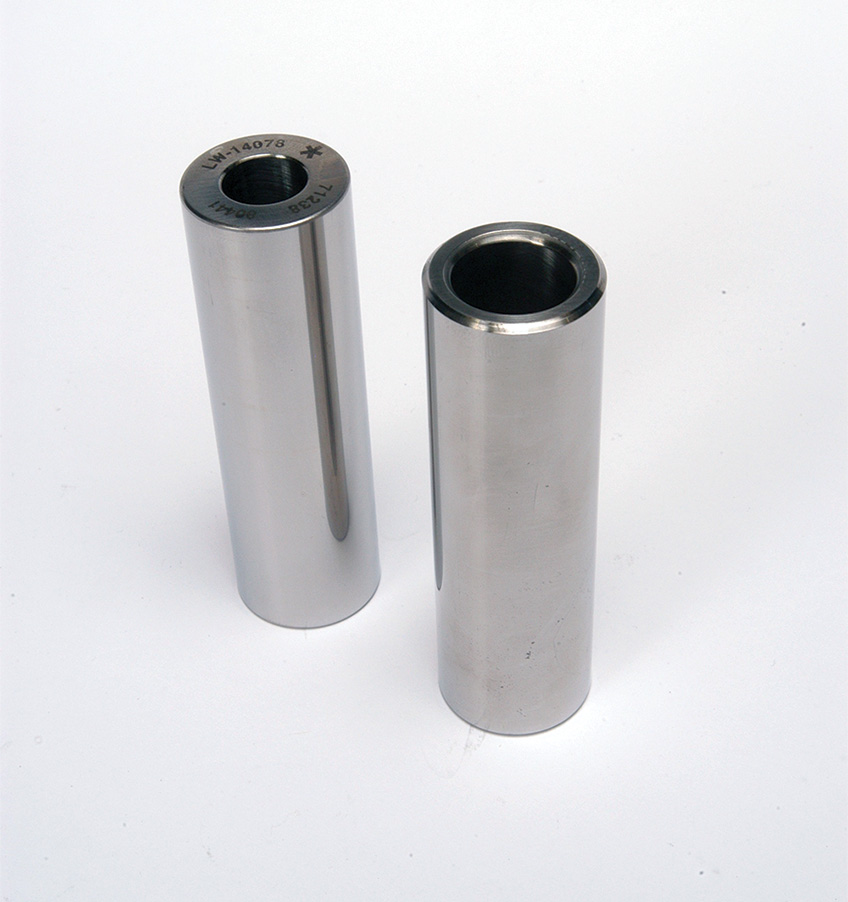
Lycoming has used two piston pins, the earlier, lighter 150-hp O-320 pin at right and the brute at left, fitted to 160-hp and up engines. The heavier pin is now the replacement pin for all Lycoming engines and Ly-Con uses it with compression ratios above 10:1 and the thinner pin for 10:1 and less compression. Both pins can be shortened about an inch for use with lightened NFS pistons. Furthermore, Lycoming uses pin plugs for pin retention, but Ly-Con deletes these in favor of circlips on its lightweight engines.
Ly-Con found more metal to cut in the cases. This is a sensitive area, as pumping half again more power through an already incredibly light engine’s case is begging for an oily windshield. So Ly-Con has limited its case lightening to removing unused bosses and locating lugs, trimming a bit of metal around the lifter bores in some instances and the occasional thick spot in others. Ironically, in other applications Ly-Con adds aluminum around the lifter bores when retrofitting roller lifters, but that’s another story.
The same thinking holds true with crankshafts. Lycoming will tell you there’s little to gain and far too much to risk in cutting down a stock Lycoming crankshaft, other than Swiss-cheesing the prop flange on non-aerobatic engines.
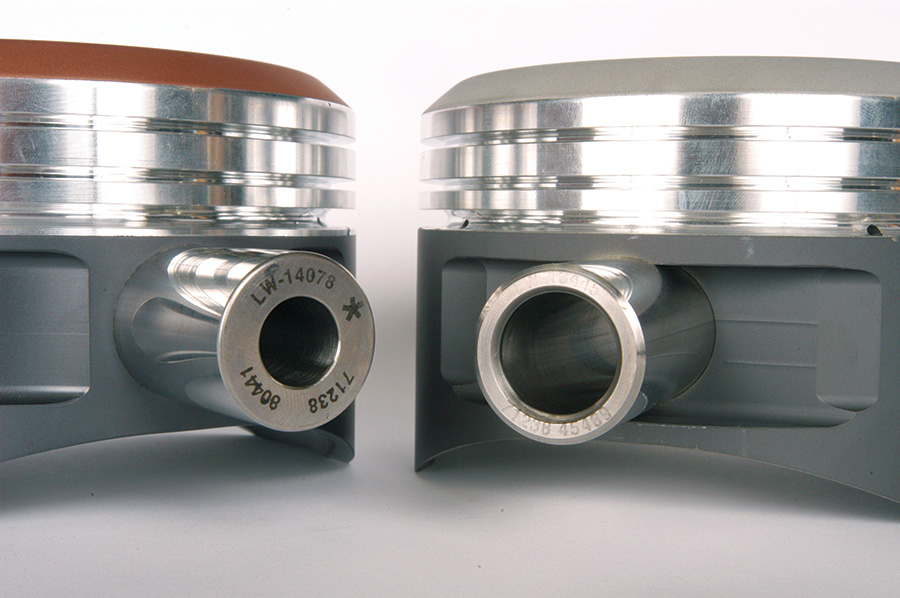
Seen edge-on, the approximately 80-gram weight advantage of the earlier thin-wall pin is obvious. Not so visible is the chamfer Ly-Con adds on the outer edge of the thin pin to work with their circlip. Not visible at all is the slight difference between Lycoming and ECI or Superior’s pin diameters (the aftermarket pins are a touch smaller). Ly-Con uses a tighter tolerance on its piston pin bores and prefers to combine its piston and the aftermarket pins to reduce the chance of galling the pin bores.
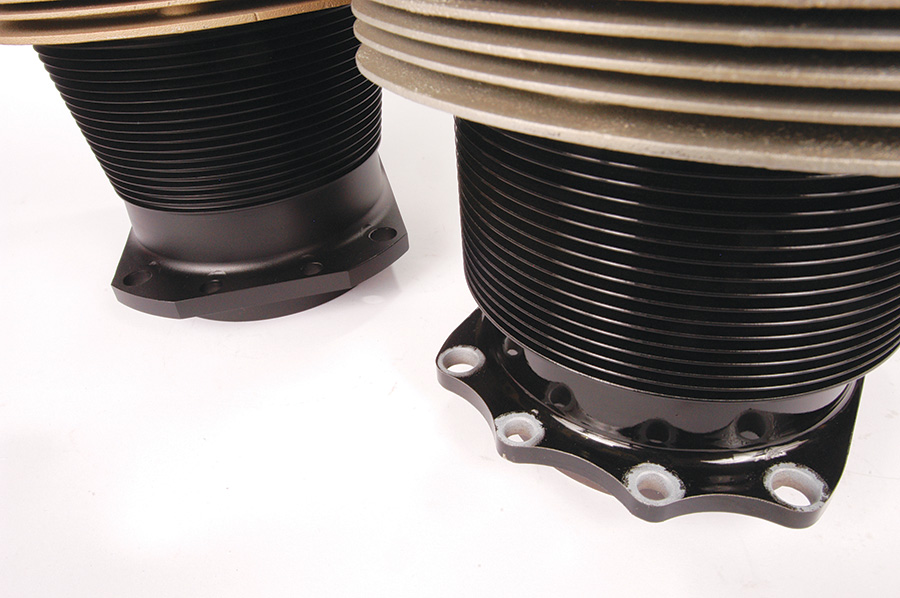
Looking down at the cylinder flanges easily shows the scalloped edge at right. Because this is steel, the weight savings is a big part of the 2.5 pounds Ly-Con removes from just the cylinder assembly itself. Add in another half pound removed from the piston and pin, and each cylinder is 3 pounds slimmer.
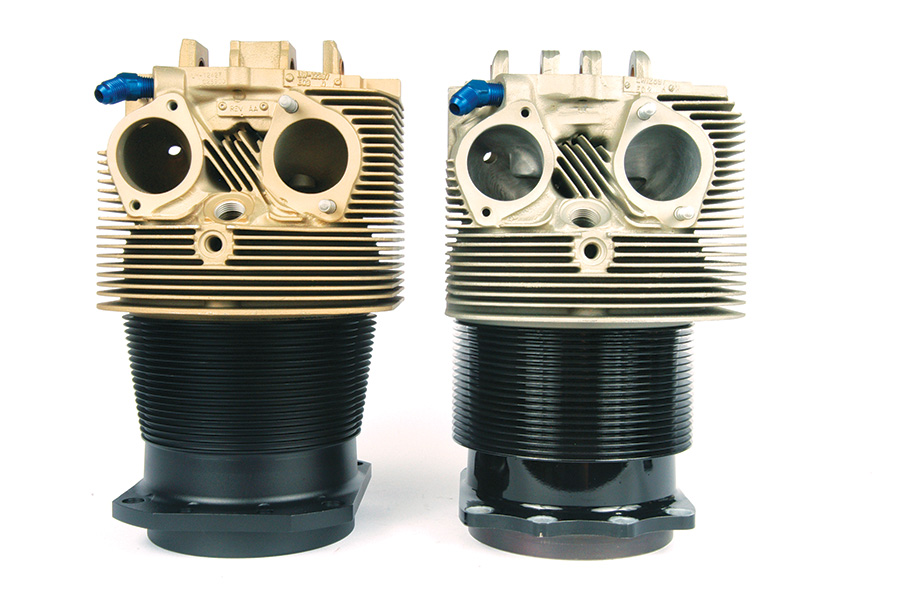
This pair of 360/540 cylinders illustrates that not all of Ly-Con’s lightening tricks necessarily end up on all cylinders. The one at left has tapered barrel fins and a plain flange, while the jug at right is the opposite. Neither cylinder has the portion of the barrel below the flange machined. On some engines, Ly-Con trims the bottom of the barrel into a sine-wave shape to reduce unnecessary barrel mass, but this can’t be done on all applications due to cracking.
Experimental with a Capital E
Then there is the stuff that so far hasn’t gotten any farther than Ly-Con’s dyno. A good example was replacing all engine hardware with titanium pieces, including the case-through studs. If nothing else, this is a pricey experiment at around $2,000 per engine—the tie-through studs are $147 apiece—and when they broke, it was back to the drawing board. Still, with the engines trimmed of excess metal as far as practical, this is a possible further lightening Ly-Con will pursue.
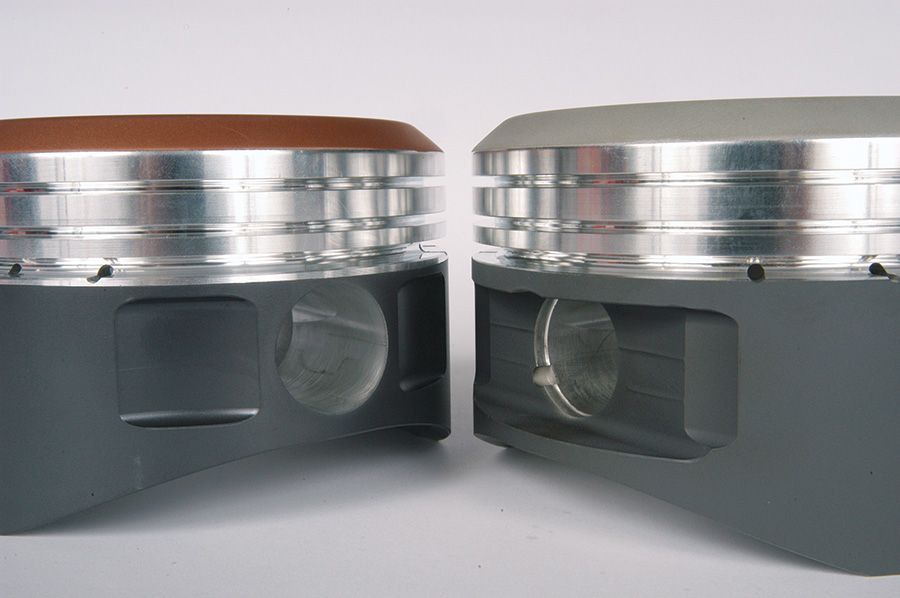
At left is a standard Ly-Con NFS forged piston, at right a lightened version with deeply scalloped flank to work with a shortened piston pin and circlip as evidenced by the retaining groove in the pin bore. Otherwise, the lightened NFS piston is unchanged, using the same conventional ring pack, pin height and dome shape.
Also in slow development are roller rocker arms. These are more of a friction-reduction item, but they also promise some weight savings. Like the titanium hardware, the roller rockers have proven too experimental so far, but they could pan out eventually.
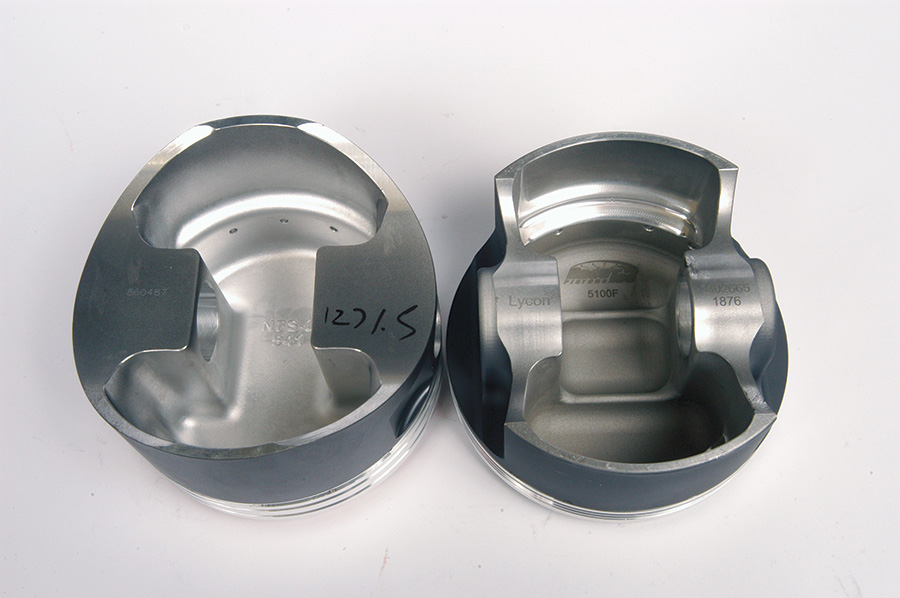
Because they cost a staggering $800 apiece, only the true race engines receive Ly-Con’s billet 540/360 piston at right. Built by Race Tec, it’s a completely different animal, with a shorter pin height and compacted ring package using Total Seal gapless rings. Its light construction is obvious in the abbreviated skirt design; a surface finish gives it a forged look.
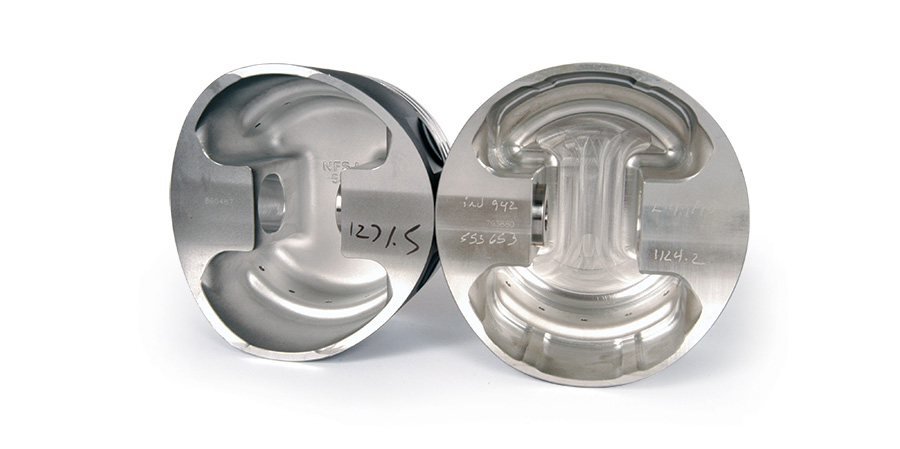
Ly-Con whittles the pin boss, underside of the dome and the skirts when lightening its NFS forgings. This saves 180 grams over a stock 8.5:1 Lycoming piston at 1262 versus 1080 grams. The cutting is done in Ly-Con’s CNC center, making it cost effective.
What’s It Worth?
What’s all the metal shaving worth, in both pounds and dollars? On a 540 parallel-valve Red Bull or equivalent engine, Ly-Con can safely remove up to 30 pounds, but this is also one reason these engines cost $62,000.
Back on earth, the rest of us could save 12 to 15 pounds on a four-cylinder engine for about $1,500, according to Ly-Con. Interestingly, just about the same money will save 15 to 20 pounds on a six-cylinder engine. If you spend time in an aerobatic box or landing on sandbars in hot canyons, this could be money well spent. It’s also an option for those fighting a forward CG issue and not wanting to put a lump of lead around the rudder post.
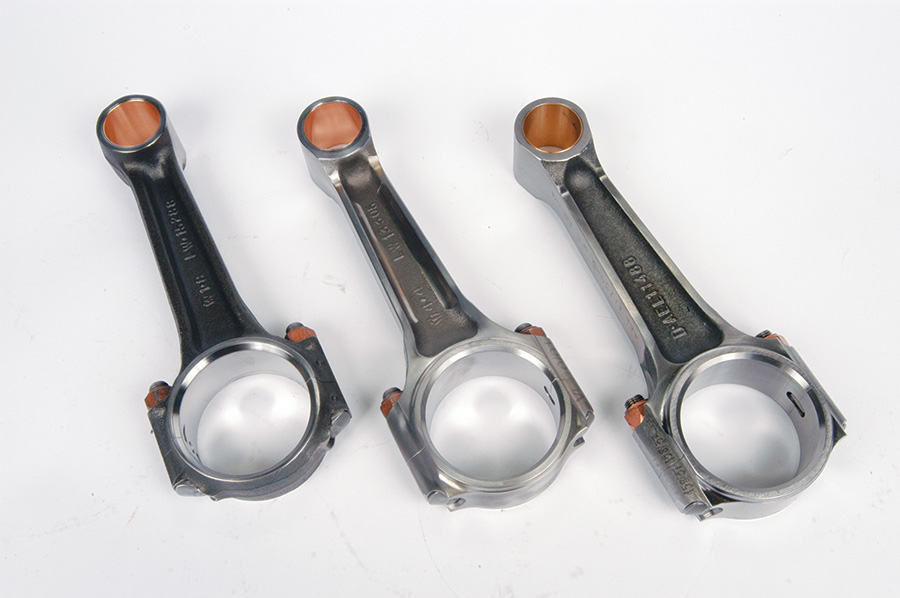
Scrounging through the existing parts bins is how Ly-Con arrived at its reduced-weight connecting rods. The two rods at left and center are Lycoming pieces; the rod at right is from ECi. From left, these rods weigh 909 grams, 992 grams and 1002 grams. Each is lightly polished on the beam, but is otherwise stock. Ly-Con uses the 909-gram rod in many of its lightweight Experimental engines.

Here’s the airboat aluminum rod that’s found its way into some of the most exotic, time-limited Ly-Con Red Bull race engines. It’s light but fatigues, as do the titanium rods Ly-Con has experimented with. Just to prove there is nothing new—and that conventional wisdom isn’t always correct—Ly-Con points out some Jacobs radial engines use aluminum rods from the factory with no apparent trouble. Go figure.
Durability
We’ll close by addressing the obvious durability question, because, after all, Lycoming put all this metal in the engine for a reason and taking it out must have consequences. In some cases, yes. Get carried away with lightweight piston pins in a 12:1 compression engine and TBO will definitely be shortened and perhaps in dramatic fashion. But stay with Ly-Con’s recommendations and TBO should remain unchanged, as long as the rest of the engine installation and operation is to an equally high standard.

The lightly stressed starter flywheel is a good place to reduce weight. The stocker at left is a hefty 6.45 pounds; after a trip through the CNC machine, the middle unit is 5.55 pounds, while trim fellow at right has also had its alternator-belt pulley removed and thus weighs just 3.70 pounds. It’s used on engines with no electrical system or small alternators mounted in place of a magneto.
For proof, Ken Tunnell, the principal at Ly-Con, points to Sean Tucker’s 400+-hp AEIO-540-EXP that Ly-Con supplies him. Anyone who’s seen half of Tucker’s routine knows this engine is the living definition of “run hard,” and it racks up over 400 hours of practice, show and ferry time each year. Yet that engine returns to Ly-Con every winter for freshening, and Tunnell says it basically looks new inside every time. He attributes much of this to Tucker faithfully warming the engine before every flight, by-the-book maintenance and a sanitary installation. There is little tolerance for leaky cooling baffles and sloppy ignition timing.
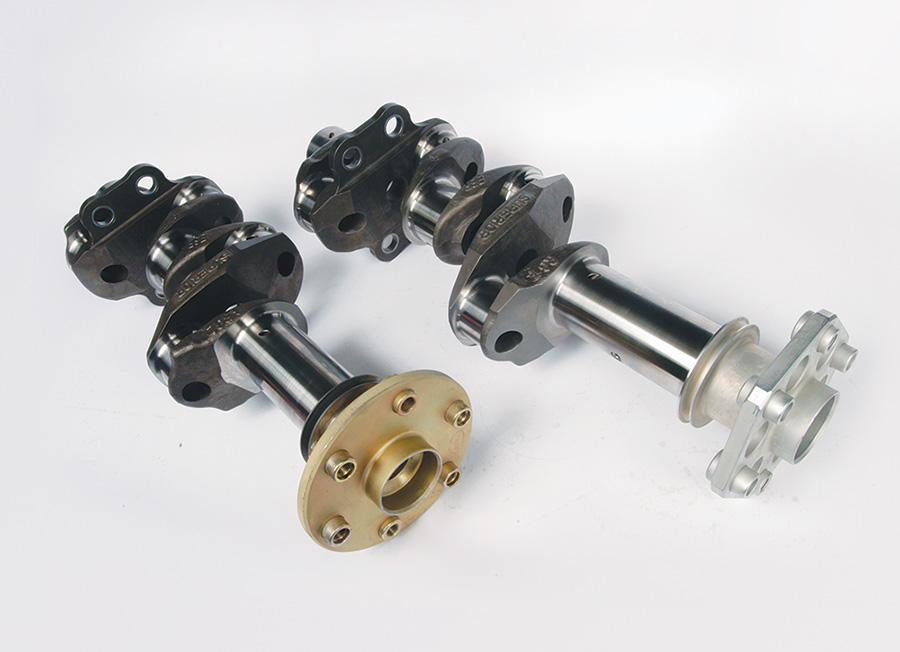
Aerobatic engines need the beef of the stock 360 crankshaft at left. It weighs 37.50 pounds and has the strength of a solid crank flange to withstand gyroscopic and inertial loads. The same crank with a lightened prop flange, below, scales 34.85 pounds, a 2.65-pound savings.
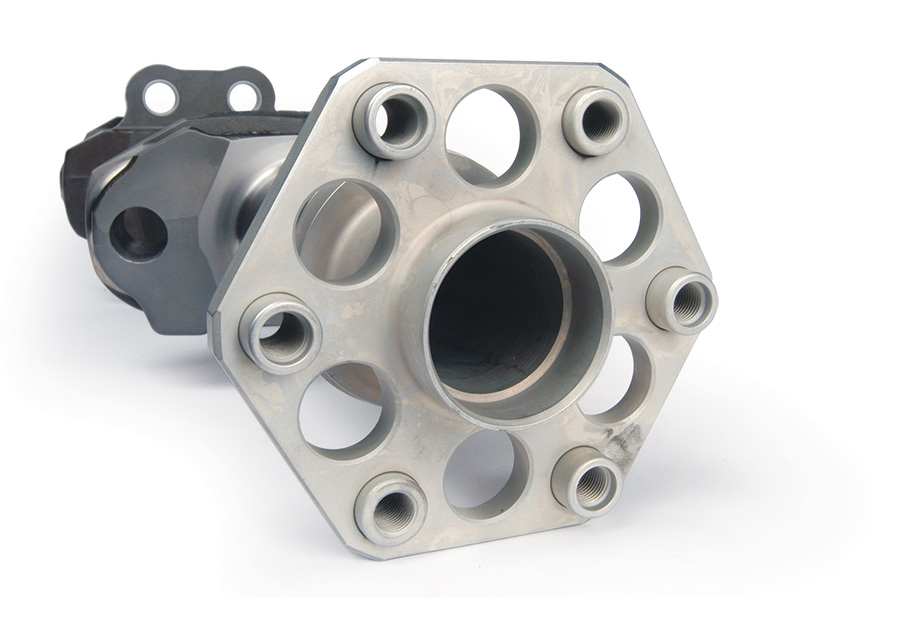
A closer look at the lightened prop flange shows it is trimmed into a hexagon, and then bored with lightening holes. The crank plug’s seating lip inside the bore is also cut down. The flange is not thinned in profile, and no other crank lightening is performed.
Of course, it might be cheaper and more productive to take 20 pounds off the pilot with a diet, but where’s the fun in that?
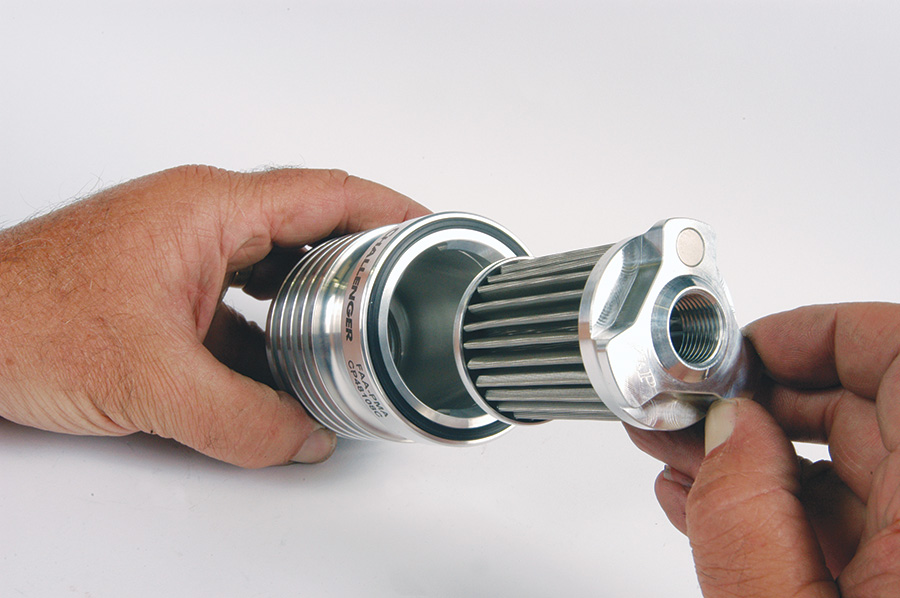
A few of Ly-Con’s customers opt for the Challenger oil filter, a $295 billet-bodied, metal-screen unit. It’s a tad smaller and 0.4 pounds lighter than a typical Champion CH48110-1 spin-on filter, but what Ly-Con really likes about it is that it’s easily inspected and cleanable, so it saves buying a new $23 filter every oil change. The small dot is a magnet for capturing iron and steel.
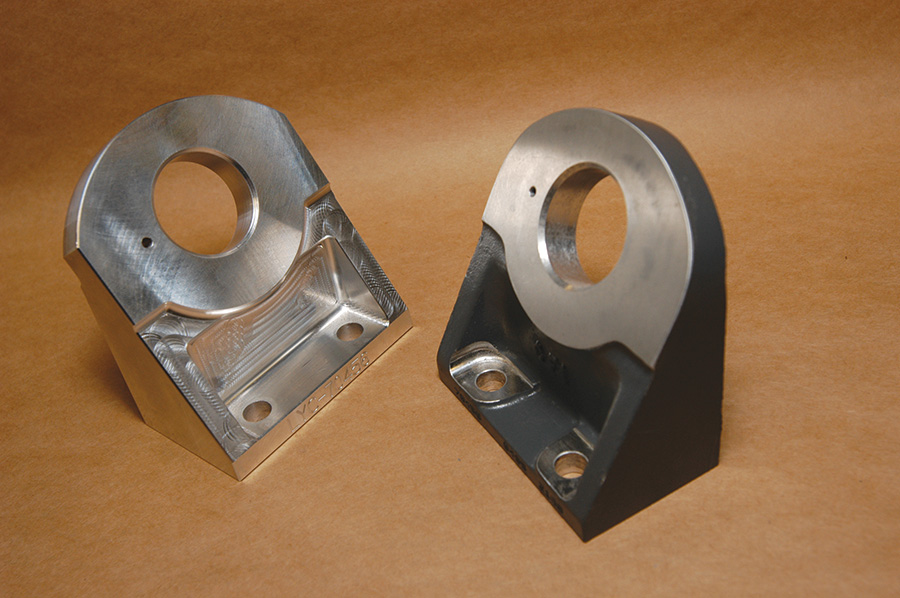
After a few crack failures of stock engine-mount brackets in extreme aerobatics, Ly-Con developed its own billet aluminum bracket, at left. Luckily they are a little lighter, too, so they’re another option should you need brackets or plan on pulling 14 G.


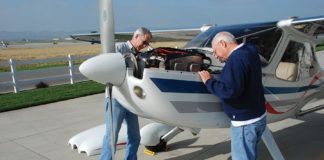
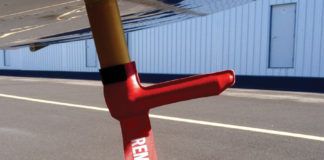
How can I order some parts??
To order Ly-Con parts give Ly-Con a call at 559 651-1070 or start with their website: https://lycon.com